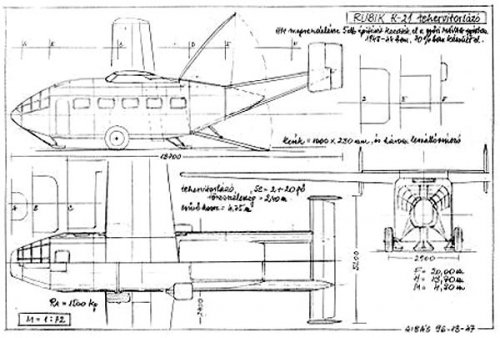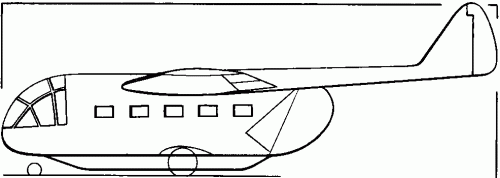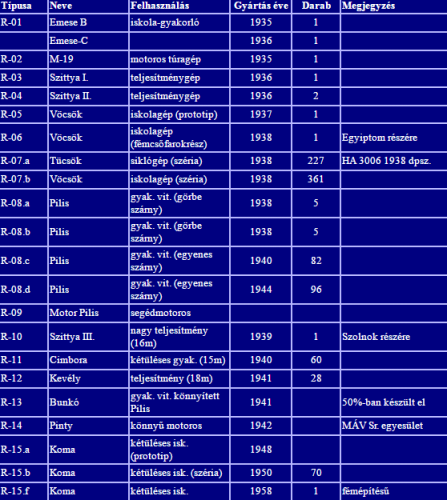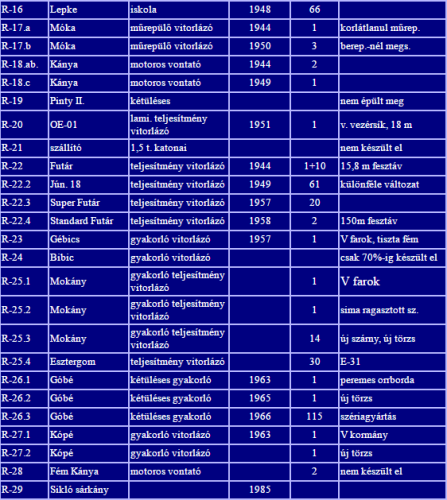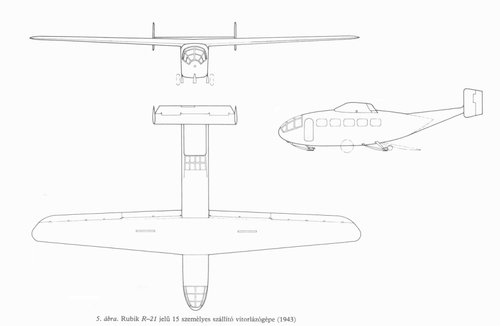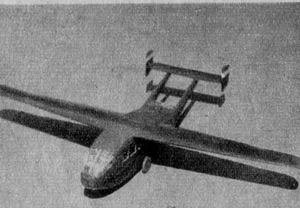Ernő Rubik Aircraft Designations
__________________________
Rubik R-01 (MSrE M-20) - single-seat sailplane (better known as EMESE-B/-C), flown 1935.
Rubik R-02 (MSrE M-19 - 2-seat cabin monoplane tourer, 130 hp (95.5 kW) DH Gypsy Major, 1 built, 1936. http://gliders-fega.fw.hu/M-19.jpg - http://en.wikipedia.org/wiki/MSrE_M-19
- M-19A (R-02a?) designation applied in 1937 after a rebuild following a crash
Rubik R-03 Szittya I (Scythian I) - gull-winged, single-seat glider, 1 built 1933
Rubik R-04 Szittya II (Scythian II) - gull-winged glider, 1937/38 1 built (12?)
Rubik R-05 Vöcsök (Grebe) - derived from R-01 EMESE-B as R-07 prototype, 1937
Rubik R-06 Vöcsök (Grebe) - as per R-05 but steel-tube fuselage frames (2 to Egypt), 1937
Rubik R-07 Vöcsök/Tücsök - single seat training glider (production series R-06), 361 built
- R-07a Tücsök (Cricket), open-frame, reduced-scale Vöcsök to replace Zögling, 1938
- R-07b Vöcsök (Grebe), productionized version of R-05/R-06 Vöcsök
- R-07c, ??
- R-07d, postwar Vöcsök with modified ailerons, 30 built 1955/'56
Rubik R-08 Pilis (Tonsure) - reduced-scale single-seat version of Szittya, 1938, 210 built
- R-08a - gull-wing, curvaceous semi-monocoque plywood fuselage, 1 built 1939; ; 82 x R-08c 1939/40; 96 x R-08d, 1944
- R-08b - simplified fuselage structure, 5 built 1938/39
- R-08c - gull replaced with pylon-mounted wing, 1939, 70 built
- R-08d - improved version with airbrakes & removeable canopy, 1943, 193 built postwar
Rubik R-09 - original designation of R-08d D-Pilis, later applied to motor conversion
- R-09 Motor Pilis - powered version of R-08d (Porsche pusher engine above wing)
Rubik R-10 Szittya III (Scythian III) - high-performance glider, 1 built 1939
Rubik R-11 Cimbora (Pal) - parasol (15m) training glider, tandem 2-seat, 60 built 1940
Rubik R-12 Kevély (Proud) - 18m span single-seat glider (enclosed cockpit)
Rubik R-13 Bunkó (Club) - lightened R-08, 50% completed 1941
Rubik R-14 Pinty (Finch) - single-seat, low-wing monoplane, 45hp Continental, 1 built 1942
Rubik R-15 Koma (Pard/Panthera) - pod-and-boom two-seat glider, flown 1948, 65 built
- R-15a Koma - prototype, 1 built 1948
- R-15b Koma - series production version, 70 built, flown 1950
- R-15f Fémkoma (Fém-Koma) - metal structure, 1 built 1958
Rubik R-16 Lepke (Butterfly) - parasol pod-and-boom single-seat training glider, 65 built
- R-16 can't be spun, wooden contruction, wings fold for storage, flown 1949
Rubik R-17 Móka (Fun) - gull-winged, single-seat sailplane, flown 1944, 3 built
- R-17a Móka, wooden construction, 13m span, open cockpit
- R-17b Móka, as per R-17/R-17a but with metal alloy tail surfaces
Rubik R-18 Kánya (Kite/Kitty Hawk) - liaison/tug aircraft, designed 1944, built 1948/'49
- R-18A powered by 130 hp (97 kW) Walter Major S 6-cyl air-cooled in-line, 1 prototype
- R-18B powered by 105 hp (78 kW) Walter Minor 4-III 6-cyl in-line, 1 prototype
- R-18 series powered by Walter Minor, converted Shvetsov M-11 5-cyl radial, 10 built
Rubik R-19 Pinttyek (Pinty II) - [Project] 2-seat, improved R-14 Pinty, not built
Rubik R-20 (OE-01) - experimental sailplane, 18m laminar-flow wing, v-tail, 1 built 1951
Rubik R-21 - [Project] pod-and-twin-boom 1.5-tonne assault glider, 5 uncompleted 1944*
-- Air Enthusiast says 5 "reached an advanced stage in construction" before abandoned
Rubik R-22 Futár (Courier) - 15m span single-seat wooden sailplane, 1943, 11 built
- R-22S (-2) Június 18, 15m span sailplane, wooden construction, flown 1950, 70 built
- R-22-3 Super Futár, 15.7m span sailplane, Futár/Június 18 successor, 12 built 1957
- powered versions: R-22S (R-22-2) Június 18, R-22-3 Super Futár, R-22-4 Standard Futár
- NB: Super Futárs are also be listed as R B-22 or R-22B and R C-22 or R-22C
Rubik R-23 Gébics (Shrike) - pod-and-boom training glider, 13m wing, v-tail, 1 built 1957
Rubik R-24 Bibic (Lapwing) - high-performance sailplane, 15m wing, v-tail, 1 built 1958Rubik R-25 Mokány (Little Devil) - single-seat sailplane, 1964-65
- R-25-3 (R-253) - 1964 standard class performance prototype
- R-25-4 (E-31) Esztergom - single-seat training sailplane, metal construction
Rubik R-26 Góbé - twin-seat sailplane, all-aluminum construction, 1961
- R-26P1 - 1960 1st prototype, v-tail
- R-26P2 - 1961 2nd prototype, conventional tail
- R-26S - series production version, 115 built 1963/'65 at Esztergom
- R-26SU - Góbé 82, renewed production version, 78 built 1982/'82 at Szombathely
- R-26M Motor Góbé - motorized Góbé (pusher engine above wing)
Rubik R-27 Kópé (Scamp) - single-seat version of 2-seat Góbé, 1962-63
- R-27P1 - 1962 1st prototype, v-tail
- R-27P2 - 1963 2nd prototype, conventional tail
Rubik R-28 Fém Kánya - [Project] improved R-18 Kánya (metal structure), not built
Rubik R-29 Sikló sárkány (Plain Dragon) - [Project] 1985
- R-29 - No details
Rubik R-30 Kacsa sárkány (Dragon Duck) - [Project] 198?
- R-30 - No details
Rubik R-31 Dupla (Double) Super Góbé - 1987 2-seat trainer, x 1
Rubik R-32 - 1987 ultra light motor glider, x 1
- R-32 HA-XBT, 2-seat light plane, Volkswagen T-2000 engine, tractor prop
[Note: a different design -- pusher-prop ultralight HA-XAJ has also been listed as a R-32B]
Rubik R-33 - 1987 ultra light motor glider, x 1
- R-33 - No details
_______________________________________

